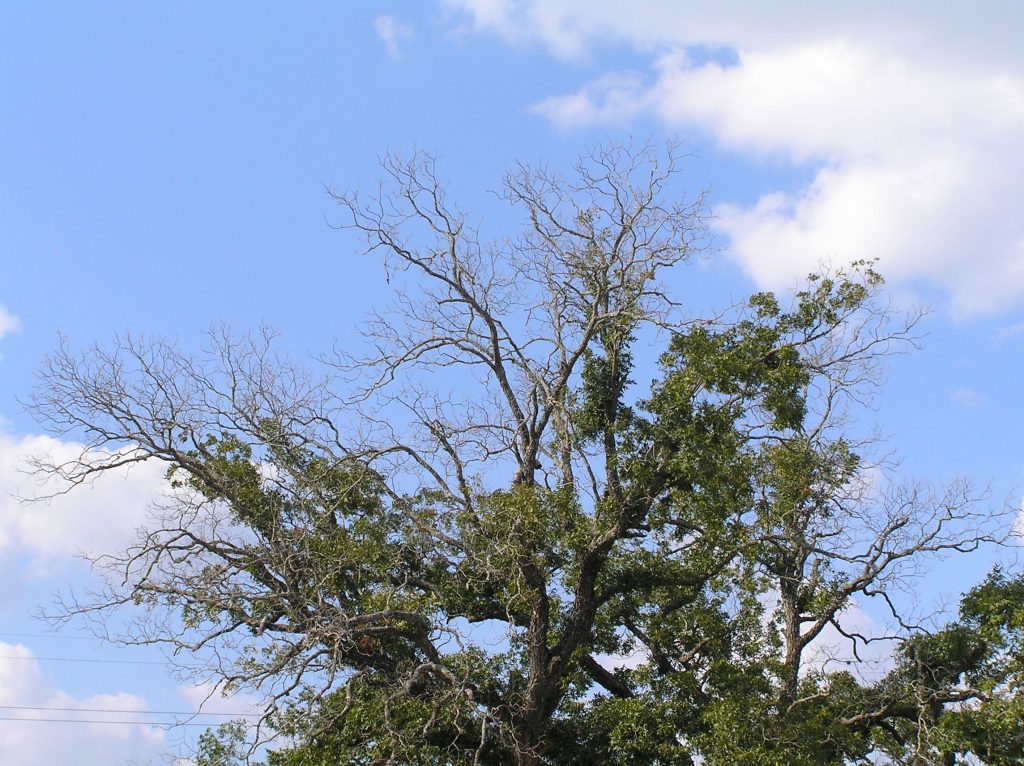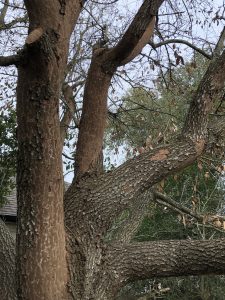This year’s drought has been quite reminiscent of the ones in 2011, except this one started earlier (and thus far seems to have ended earlier). Unlike the 90 plus days of 100 plus degree heat in 2011, this year’s number of super hot days was much lower (again, thus far), but because it started earlier, many trees still struggled or died. In fact, this was the first spring in my business’ 40 year history that I was calling my clients to recommend that they irrigate their trees.
Yet the good news is that probably because we had far fewer hot days, we have not seen near the tree losses state-wide that we did in 2011, when losses were in the millions. There were areas around Brownwood (aptly named after 2011) that had acres and acres of trees die (many of them junipers). Here in Austin, it seemed as if we lost 5 or 10% of the pecan trees on the east side, and even live oaks, the sturdiest tree in the forest, suffered significant losses, especially on high grounds. The area uphill from Barton Springs Pool, near the polo fields (better known as the overflow parking dustbowl) lost quite a few live oaks. So the losses were city- and species-wide.

Dieback in pecan from drought stress
The dieback shown here is typical of what is seen with drought stress. It may look very familiar to those who experienced the frozen hell imposed on us by Governor Abbott and his PUC cronies on Valentines Day 2021 (yeah, I said it- this is my damn blog!). It is not unusual for plants to have a similar reaction to very different problems; overwatering and underwatering can both make a houseplant’s leaves turn yellow. With drought though, there’s usually some browning on the edges of the leaves first.

Bisconiauxia atropunctata
Here’s another example of something we often seen with drought stress; a fungus that is one of the few that can act in trees as both a decay organism and a pathogenic agent: Bisconiauxia. The name’s a mouthful (and that’s only the genus). While most frequently seen in response to drought, an arboriculture professor at A&M says it can also be seen in response to flooding (there’s that same response- different cause thing again). It comes in lots of pretty colors- white, silver, pink, brown, grey, black- usually depending on the tree it’s on, and it can be found on many species here in central Texas- all oaks, pecans, sycamores, hackberries, and more. In this photo, of a live oak killed by freeze, the fungus is the brown, smooth areas covering the two upright limbs. In this case it was acting as a decay agent. Be aware there is no treatment for this disease, still often referred to by its previous name, Hypoxylon, so don’t be conned by anyone saying they can treat it, although if present in only small sections of an otherwise vigorous tree, the tree can sometimes survive if those sections are pruned out.
So how can we treat drought stressed trees? Is water too obvious an answer? I find that getting ahead of it helps. Meaning, don’t wait until we’re in our fourth week of no rain and 90-plus degree temps to start watering. How should you water a tree? Great question. So often when I tell people to water their trees, I come back to find they’ve put a hose end to the base of the trunk and let it run. This can work for a tree as big as your wrist, but not for one much more than that. Most of the roots in that area are large buttressing roots, which don’t take up water. The uptake of water and nutrients is done by very fine so-called hair roots. Concentrating a lot of water in this so-called root collar area can also increase the probability of root rot. Another technique people have often heard of is to lay a soaker hose at the outer edge of the canopy. Well, better than the first approach for sure, but still not great in my opinion. Yes, many of the hair roots are found in this part of the root zone, but there are many hair roots found throughout the area underneath the canopy of the tree- and besides, many times the edge of the canopy of a large tree on an urban lot is out in the street or in the neighbor’s yard. And a single ring of soaker hoses really won’t put out enough water for a big tree. I recommend using a regular lawn sprinkler and uniformly watering the entire area under the canopy, and slightly beyond if possible, while minimizing water on the trunk.
How much to water? That’s another tricky one. There are many different soil types and water system pressures to consider. A really good way to figure this out is water the area defined for about a half an hour. Then, about 12 hours later dig down to about six inches in a few spots around the area watered. If it is slightly damp at that depth, you’ve watered enough. If it’s dry try again in a few days with a longer running time. If it’s wet, back off next time. Another technique is to put several tuna fish cans (cleaning them first would be a good idea) around the area being watered. Water enough to put about an inch in each of the cans on average. Watering once a week should be enough.
Ever notice that no matter how much you water, even if you put down an inch or more at a time, the trees (and the lawn, and everything else) just don’t respond the way they do after even a short rain? Why is that? Many arborists in Austin have pondered that mystery, and the consensus I’ve heard is chlorine or its by-products. Sounds like a good theory to me, so I’m sticking with that.
A great way to minimize drought stress in your trees is to make sure your soil is optimum. The best way to do that is to make sure it has a good organic content. This can be achieved by lightly composting your turf once a year, ideally in spring or fall. Better yet, remove large areas of turf, especially thirsty ones like St. Augustine, which are heavy competitors for both water and nutrients, from under the canopies of your trees, and replace them with more natural ecosystems like mulch and native shrubs and grasses. St. Augustine turf is especially tough on young trees. Give them a large area of mulch, about three inches deep.
Speaking of nutrients, many homeowners (and less scrupulous tree companies) often want to fertilize drought-stressed trees. While fertilizer has its place (see my post on fertilizing), it should be avoided on drought-stressed trees. Fertilizers are mainly salts, and can increase the risk of root death by drawing water out of roots. Fertilizing is one of those “magic pill” treatments oversold by too many tree companies out there (again, see my fertilizing post for details).
Bottom line, when things get hot, it’s tough on all living things. And they say that things are only going to get worse, what with anthropogenic climate change and all. What? Who’s they? Just 99% of the world’s scientists. Yeah, it’s a thing….
